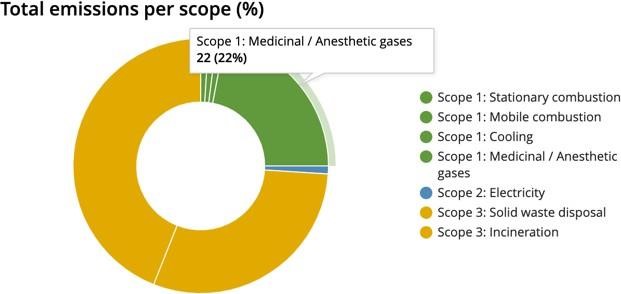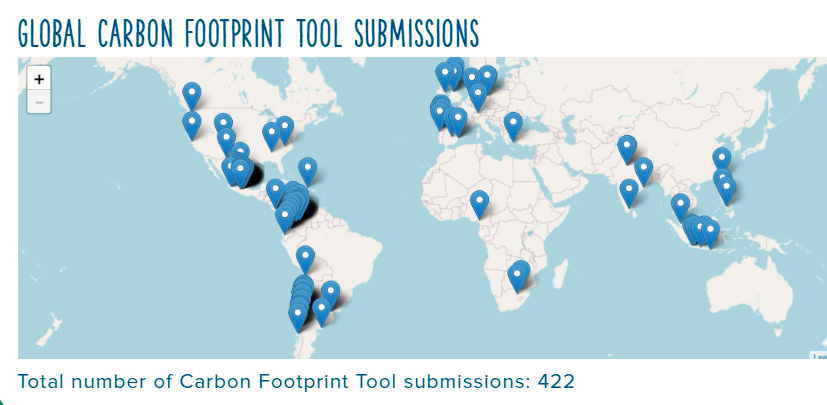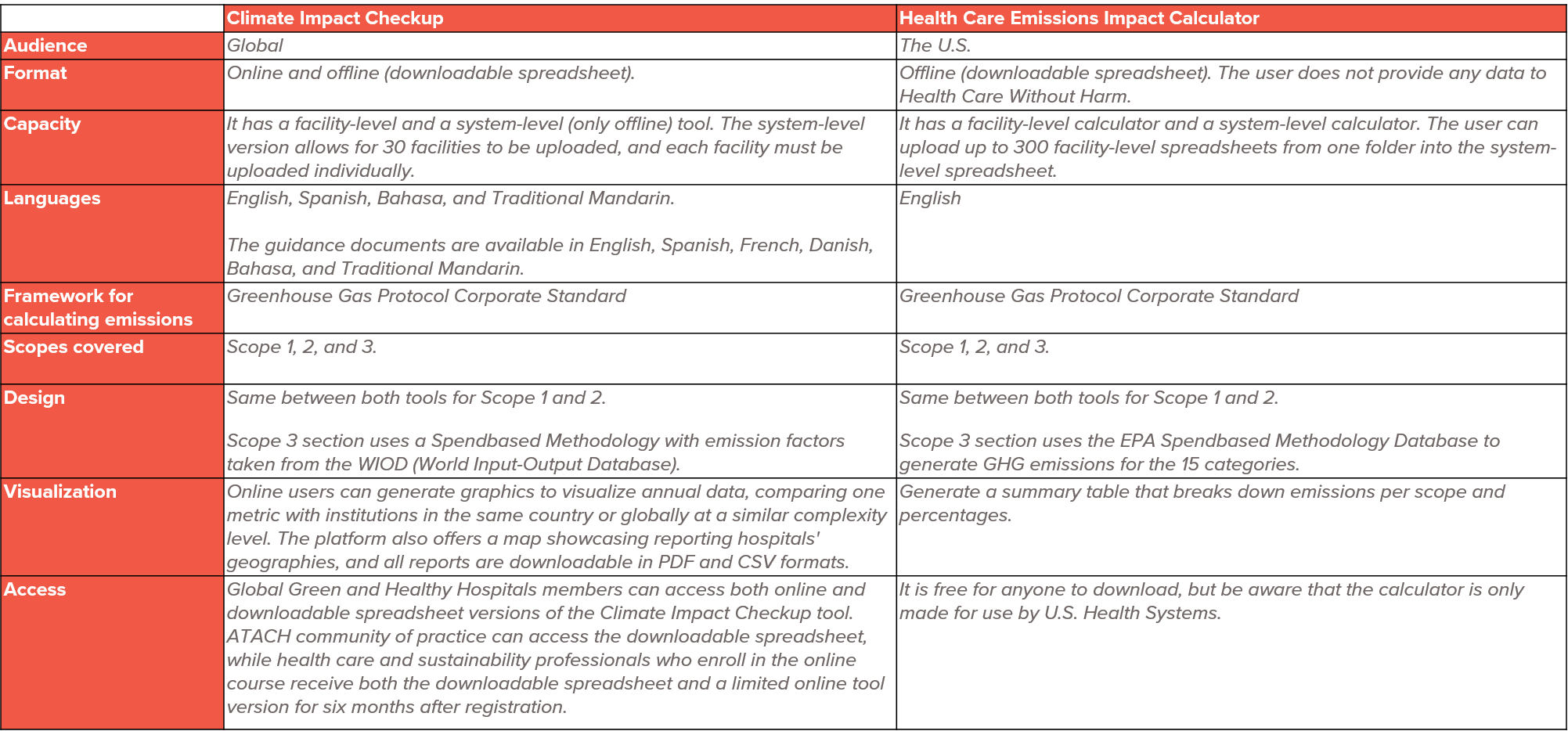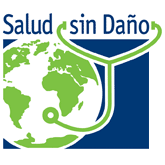Climate Impact Checkup FAQs
Health care’s GHG emissions calculator
March 2023
1. What is Climate Impact Checkup?
Climate Impact Checkup (CIC) tool estimates greenhouse gas (GHG) emissions from health car institutions using data primarily from energy consumption, transport, waste management, expenditures, and other activities relevant to the sector’s climate impact. It calculates the carbon footprint based on national emission factors, when available and applicable. Health care systems and facilities are able to benchmark their footprint against similar facilities in their country, region, and globally.
The calculator is expected to be used by health care facilities globally to set a baseline, identify priorities, develop plans, and promote action for carbon reduction in operations and some procurement procedures.
2. What are the benefits of using Climate Impact Checkup?
In addition to providing carbon footprint data and establishing a mitigation starting point, CIC tool also gives you access to a peer network, where members can share experiences and advice through discussion forums and a global community of practice.
3. What are some of Climate Impact Checkup’s features?
The calculator is aligned with the GHG Protocol, has healthcare-specific emissions such as those produced from using anesthetic gases and inhalers, and contains emission factors per country when available and applicable, to allow for accurate health facilities’ footprint estimation in most countries. For instance, in electricity, CIC uses national and subnational values of more than 200 nations and territories. CIC can be downloaded as a spreadsheet. It is accompanied by a guide to support users and direct them to resources to reduce their footprint.
4. Who can use the calculator?
Members of the Global Green and Healthy Hospitals (GGHH) to the Climate Impact Checkup tool, available in English, Spanish, Bahasa Indonesia, Mandarin, and Japanese.
Members of the ATACH community of practice, and health care and sustainability professionals who enroll in the online course will receive access to the tool.
Health ministriesparticipating in ATACH can also join Health Care Without Harm’s Global Green and Healthy Hospitals Network. Current members include Ministries of Health from Bhutan, Colombia, Ethiopia, Maldives, Peru, Thailand, and Vietnam, as well as several sub-national health authorities.
Requests and questions can be referred to checkup@hcwh.org.
5. What GHG emission sources does Checkup calculate?
The sources covered in CIC were selected either because of their relevance to global emissions and/or because they were health care sector-specific (such as fugitive emissions from medicinal gases) as well as for the ability to get representative and accurate data. The feedback Health Care Without Harm receives from its users is essential, and the tool is consistently improved and updated. Below are the sources emissions by Scope.
All calculations for Scopes 1, 2, and 3 are based on activity data. Scope 3 extra supply chain calculations are spend-based data and use a different methodology, with emission factors for 43 countries (for the remaining countries, it uses a Rest of the World estimation).
Future developments and improvements
More emissions sources will be added along with more local/specific data. Some sources currently being analyzed for future inclusion are wastewater treatment and electromobility. Users' feedback from all regions provide important information about the priorities and needs at the facility and system levels.
6. What resources does the Checkup provide to GGHH, Practice Greenhealth and Health Ministries members?
The CIC tool can be downloaded through GGHH Connect and Health Care Without Harm's training platform. Other resources include:
- Discussion forum and community of practice
- Workshops to learn how to use the tool and increase the quality of inventories
- Guidelines to use the tool, set goals, and create action plans
Health Care Without Harm developed an online course on the CIC tool and the development of carbon management plans.
7. Is Checkup user data and information confidential?
All data is treated with absolute confidentiality. For example, the map only shows the location of the report by state, (not city), level of complexity and number of reports shared by that institution and does not show the name of the institution.


8. What are the key differences between the Climate Impact Checkup and the Health Care Emissions Impact Calculator?
The Climate Impact Checkup and Health Care Emissions Impact Calculator are tools Health Care Without Harm developed, both designed to assist health care organizations in measuring their greenhouse gas (GHG) emissions. Despite sharing this common goal, they differ in their primary target audiences. The Climate Impact Checkup caters to a global audience, while the Health Care Emissions Impact Calculator specifically targets U.S. health systems.
We present below a detailed summary of the differences and similarities between them:

About Health Care Without Harm
Health Care Without Harm works through regional offices in Asia, Europe, and the United States; a regional team in Latin America; and country-level partnerships with national organizations in Australia, Brazil, China, India, Nepal, and South Africa. Our mission is to transform health care worldwide so that it reduces its environmental footprint, becomes a community anchor for sustainability and a leader in the global movement for environmental health and justice.
We have a comprehensive set of partnerships with health organizations, health professionals, international organizations, and government ministries, comprising a global network of more than 1,700 members who represent the interests of more than 70,000 hospitals and health centers in 82 countries worldwide (May 2023 data).
To contact Health Care Without Harm about Climate Impact Checkup, please email: checkup@hcwh.org
